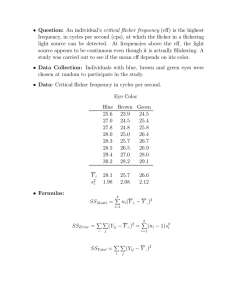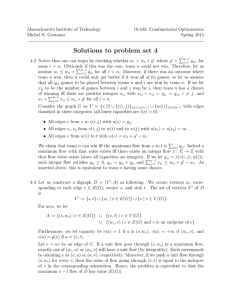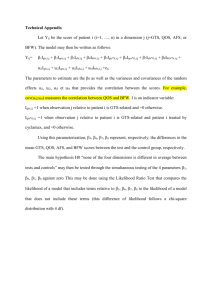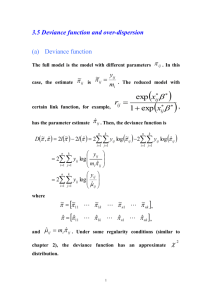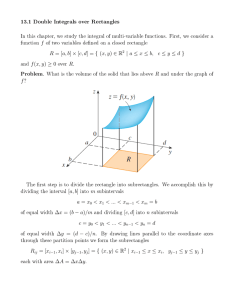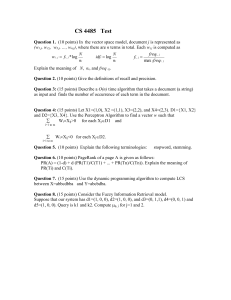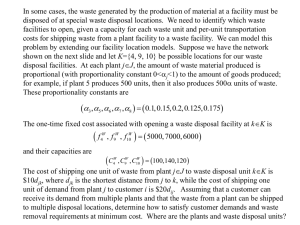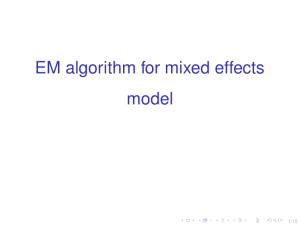Generalized linear mixed models 1/15
advertisement
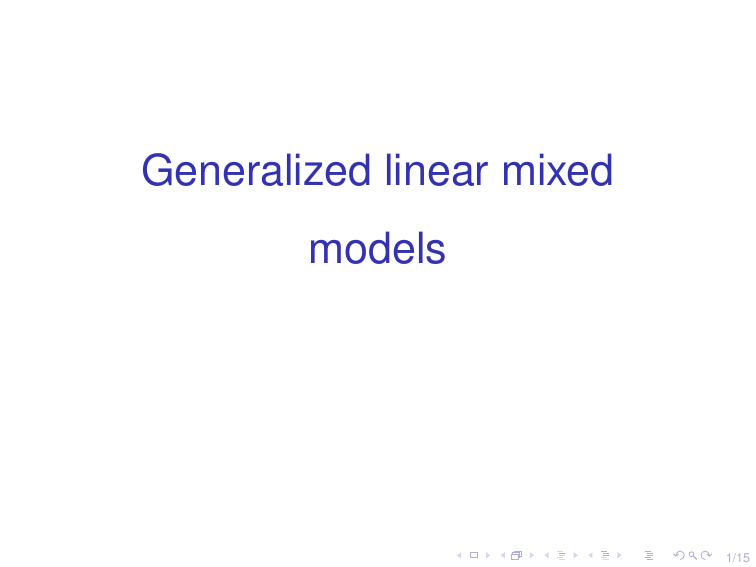
Generalized linear mixed
models
1/15
Example: crossover trial
I
This is a crossover trial designed to compare two drugs
(Jones and Kenward, 1989): active drug (A) and placebo
(B) on cerebrovascular deficiency.
I
34 patients received drug A followed by placebo (AB).
I
33 patients received drug B followed by drug A (BA).
I
The response variable is defined to be 0 for an abnormal
electrocardiogram reading, and 1 for a normal reading.
2/15
Example: crossover trial
Responses
Period
Group
(1,1)
(0,1)
(1,0)
(0,0)
Total
1
2
AB
22
0
6
6
34
28
22
BA
18
4
2
9
33
20
22
3/15
Example: crossover trial
Let Yij be the response variable for the i-th person in the j-th
period.
1 a normal reading;
Yij =
0 an abnormal reading.
A simple model is
logit{P(Yij = 1)} = log
P(Yij = 1)
1 − P(Yij = 1)
= β0 + β1 xij
for i = 1, · · · , 67; j = 1, 2
where xij indicates if the person received placebo (xij = 0) or
active drug (xij = 1).
4/15
Dependence
I
The above simple model did not consider the correlation
between Yi1 and Yi2 , two observations from the same
subject.
I
Because the measurements are obtained from the same
individual, they are naturally dependent to each other.
I
We should model the dependence among measurements
taken from the same individual.
5/15
Example continued
To model the dependence, a more realistic model could be
P(Yij = 1|Ui )
logit{P(Yij = 1|Ui )} = log
1 − P(Yij = 1|Ui )
= β0 + Ui + β1 xij
for i = 1, · · · , 67; j = 1, 2
where Ui is a random intercept.
6/15
Example continued
I
For the i-th person in the placebo group, the risk is
logit P(Yij = 1|Ui , xij = 0) = β0 + Ui .
I
If this person is in the active drug group, then
logit P(Yij = 1|Ui , xij = 1) = β0 + β1 + Ui .
I
Each individual has its own risk. The treatment effect is
measured by the unknown parameter β1 . The question of
interest is to estimate β1 .
7/15
Logistic regression model with random intercept
In general, consider the logistic regression model with random
intercept for binary data
logit P(Yij = 1|Ui ) = β0 + Ui + xijT β,
where Ui is a random intercept and xij is a p-dim predictor.
8/15
Estimation of unknown parameters
I
The goal is to estimate the unknown parameters β in the
logistic regression model with random intercept.
I
The likelihood approach is computational difficult for the
above model because of the existence of random effects.
I
A conditional likelihood approach will be introduced for
estimating β. The conditional likelihood approach is easy
for computation.
9/15
Conditional likelihood approach
Consider the logistic regression model with random intercept as
following:
Yij |Ui
independent
∼
log
pij
1 − pij
Bernoulli(pij );
= γi + xijT β,
where γi = β0 + Ui , i = 1, · · · , m and j = 1, · · · , ni .
10/15
Conditional likelihood approach
I
The basic idea of conditional likelihood approach is
treating the random intercepts γi as fixed parameters, and
then decompose the full likelihood for β and γi into a
conditional likelihood and a marginal likelihood.
I
We wish the conditional likelihood depends only on the
unknown parameter β but has nothing to do with γi .
I
To make the conditional likelihood free of parameters γi , a
natural approach is to find the sufficient statistics for γi .
11/15
Conditional likelihood approach
I
The conditional likelihood for β given the sufficient
statistics for γi is
P i
exp( nj=1
Yij xijT β)
,
CL(β) =
P
Pni
T β)
exp(
Y
x
il
R
il
l=1
i
i=1
m
Y
P i
where Yi· = nj=1
Yij and the index set Ri contains all the
ni
Yi· ways of choosing Yi· positive responses out of ni
P i
repeated observations such that nl=1
Yil = Yi· .
I
Then the estimation of β can be obtained as the maximizer
of the above conditional likelihood function CL(β).
12/15
Example: crossover trial
Responses
Group
(1,1)
(0,1)
(1,0)
(0,0)
AB
a1
b1
c1
d1
BA
a2
b2
c2
d2
13/15
Example continued
Recall that the logistic regression model with random intercept
is
logit{P(Yij = 1|Ui )} = log
P(Yij = 1|Ui )
1 − P(Yij = 1|Ui )
= β0 + Ui + β1 xij ,
where xij indicates if the person received placebo (xij = 0) or
active drug (xij = 1), and Ui is a random intercept. The interest
is to estimate β1 , which indicates the treatment effect.
14/15
Example: crossover trial
The conditional likelihood for β1 is
CL(β1 ) =
exp(β1 )
1 + exp(β1 )
b2 +c1 1
1 + exp(β1 )
b1 +c2
.
The maximum conditional likelihood estimator of β1 is
c1 + b2
β̂1 = log
.
b1 + c2
15/15
